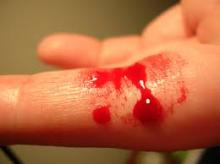User login
SAN DIEGO – A small study of infants with severe hemophilia A revealed that there are four distinct patient subgroups based on their unique antibody signatures.
Bagirath Gangadharan, PhD, and his colleagues reported the results of HIPS, the Hemophilia Inhibitor Previously Untreated Patient Study, in a poster at the annual meeting of the American Society of Hematology.
The findings included data on 23 infants who had a baseline Factor VIII coagulant activity of less than 0.01 IU/mL at enrollment in the study. All patients received a single type of recombinant FVIII replacement therapy (Advate by Baxalta) with the dose, frequency, and regimen at the discretion of the treating physician.
Patients with prior exposure to clotting factor concentrates or blood products, another clinically significant chronic disease, and those participating in another investigational drug study were excluded.
The researchers discovered that patients fell into four distinct subgroups based on their antibody characteristics after 50 days’ exposure to FVIII infusions:
- Subgroup one, which included seven patients, had no detectable FVIII-specific antibodies and no FVIII inhibitors.
- Subgroup two – also made up of seven patients – had FVIII-specific IgG1, no detectable IgG class–switched antibodies, and no FVIII inhibitors.
- The third subgroup included just two patients. These patients had FVIII-specific IgG1, no detectable IgG class–switched antibodies, but low-titer FVIII inhibitors.
- The final subgroup, which had seven patients, had FVIII-specific IgG1, high-affinity IgG class–switched antibodies (IgG3, IgG4, and IgG2), and FVIII inhibitors.
The researchers concluded that high-affinity FVIII-specific class-switched antibodies precede clinical FVIII inhibitor detection, adding to the evidence of their “potential role as suitable predictive biomarkers for inhibitor development.”
The study is funded by Baxalta, a part of Shire. Dr. Gangadharan is employed by Shire and other authors reported financial disclosures related to the study sponsor.
SOURCE: Gangadharan B et al. ASH 2018, Poster 3774.
SAN DIEGO – A small study of infants with severe hemophilia A revealed that there are four distinct patient subgroups based on their unique antibody signatures.
Bagirath Gangadharan, PhD, and his colleagues reported the results of HIPS, the Hemophilia Inhibitor Previously Untreated Patient Study, in a poster at the annual meeting of the American Society of Hematology.
The findings included data on 23 infants who had a baseline Factor VIII coagulant activity of less than 0.01 IU/mL at enrollment in the study. All patients received a single type of recombinant FVIII replacement therapy (Advate by Baxalta) with the dose, frequency, and regimen at the discretion of the treating physician.
Patients with prior exposure to clotting factor concentrates or blood products, another clinically significant chronic disease, and those participating in another investigational drug study were excluded.
The researchers discovered that patients fell into four distinct subgroups based on their antibody characteristics after 50 days’ exposure to FVIII infusions:
- Subgroup one, which included seven patients, had no detectable FVIII-specific antibodies and no FVIII inhibitors.
- Subgroup two – also made up of seven patients – had FVIII-specific IgG1, no detectable IgG class–switched antibodies, and no FVIII inhibitors.
- The third subgroup included just two patients. These patients had FVIII-specific IgG1, no detectable IgG class–switched antibodies, but low-titer FVIII inhibitors.
- The final subgroup, which had seven patients, had FVIII-specific IgG1, high-affinity IgG class–switched antibodies (IgG3, IgG4, and IgG2), and FVIII inhibitors.
The researchers concluded that high-affinity FVIII-specific class-switched antibodies precede clinical FVIII inhibitor detection, adding to the evidence of their “potential role as suitable predictive biomarkers for inhibitor development.”
The study is funded by Baxalta, a part of Shire. Dr. Gangadharan is employed by Shire and other authors reported financial disclosures related to the study sponsor.
SOURCE: Gangadharan B et al. ASH 2018, Poster 3774.
SAN DIEGO – A small study of infants with severe hemophilia A revealed that there are four distinct patient subgroups based on their unique antibody signatures.
Bagirath Gangadharan, PhD, and his colleagues reported the results of HIPS, the Hemophilia Inhibitor Previously Untreated Patient Study, in a poster at the annual meeting of the American Society of Hematology.
The findings included data on 23 infants who had a baseline Factor VIII coagulant activity of less than 0.01 IU/mL at enrollment in the study. All patients received a single type of recombinant FVIII replacement therapy (Advate by Baxalta) with the dose, frequency, and regimen at the discretion of the treating physician.
Patients with prior exposure to clotting factor concentrates or blood products, another clinically significant chronic disease, and those participating in another investigational drug study were excluded.
The researchers discovered that patients fell into four distinct subgroups based on their antibody characteristics after 50 days’ exposure to FVIII infusions:
- Subgroup one, which included seven patients, had no detectable FVIII-specific antibodies and no FVIII inhibitors.
- Subgroup two – also made up of seven patients – had FVIII-specific IgG1, no detectable IgG class–switched antibodies, and no FVIII inhibitors.
- The third subgroup included just two patients. These patients had FVIII-specific IgG1, no detectable IgG class–switched antibodies, but low-titer FVIII inhibitors.
- The final subgroup, which had seven patients, had FVIII-specific IgG1, high-affinity IgG class–switched antibodies (IgG3, IgG4, and IgG2), and FVIII inhibitors.
The researchers concluded that high-affinity FVIII-specific class-switched antibodies precede clinical FVIII inhibitor detection, adding to the evidence of their “potential role as suitable predictive biomarkers for inhibitor development.”
The study is funded by Baxalta, a part of Shire. Dr. Gangadharan is employed by Shire and other authors reported financial disclosures related to the study sponsor.
SOURCE: Gangadharan B et al. ASH 2018, Poster 3774.
REPORTING FROM ASH 2018
Key clinical point:
Major finding: Two of the subgroups had Factor VIII inhibitors and two of the subgroups did not.
Study details: The study included 23 infants with previously untreated severe hemophilia A who received 50 days’ exposure to FVIII infusions.
Disclosures: The study is funded by Baxalta, a part of Shire. Dr. Gangadharan is employed by Shire and other authors reported financial disclosures related to the study sponsor.
Source: Gangadharan B et al. ASH 2018, Poster 3774.

